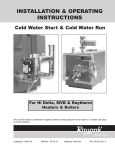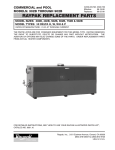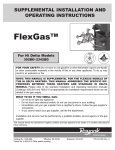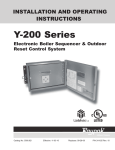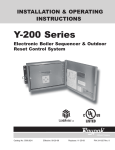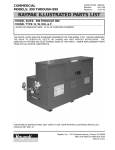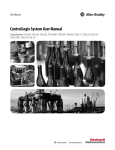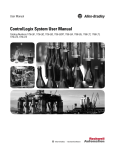Download Raypak 241275 Operating instructions
Transcript
INSTALLATION AND OPERATING INSTRUCTIONS COLD WATER START & COLD WATER RUN For Hi Delta & MVB Heaters & Boilers This manual should be maintained in legible condition and kept adjacent to the heater or in another safe place for future reference. Catalog No: 1000.57A Effective: 02-28-07 Replaces: 02-24-06 P/N 241275 Rev. 2 2 GENERAL SAFETY To meet commercial hot water use needs, the high limit safety control on this water heater is adjustable up to 210°F. However, water temperatures over 125°F can cause instant severe burns or death from scalds. When supplying general purpose hot water, the recommended initial setting for the temperature control is 125°F. Safety and energy conservation are factors to be considered when setting the water temperature on the thermostat. The most energy-efficient operation will result when the temperature setting is the lowest that satisfies the needs of the application. Water temperature over 125°F can cause instant severe burns or death from scalds. Children, disabled, and elderly are at highest risk of being scalded. Water temperature over 125°F can cause instant severe burns or death from scalds. Children, disabled and elderly are at highest risk of being scalded. • • See instruction manual before setting temperature at water heater. Feel water before bathing or showering. Feel water before bathing or showering. Temperature limiting valves are available. Temperature limiting valves are available, see manual. NOTE: When this water heater is supplying general purpose hot water for use by individuals, a thermostatically controlled mixing valve for reducing point of use water temperature is recommended to reduce the risk of scald injury. Contact a licensed plumber or the local plumbing authority for further information. Time/Temperature Relationships in Scalds The following chart details the relationship of water temperature and time with regard to scald injury and may be used as a guide in determining the safest water temperature for your applications. Maximum water temperatures occur just after the heater’s burner has shut off. To determine the water temperature being delivered, turn on a hot water faucet and place a thermometer in the hot water stream and read the thermometer. Water Temp. Time to Produce Serious Burn 120°F More than 5 minutes 125°F 1-1/2 to 2 minutes 130°F About 30 seconds 135°F About 10 seconds 140°F Less than 5 seconds 145°F Less than 3 seconds 150°F About 1-1/2 seconds 155°F About 1 second Table courtesy of The Shriners Burn Institute Table A: Time to Produce Serious Burn 3 COLD WATER START Before arriving at the job site to begin the installation, it's important to first inspect the system and determine what materials you will need. Some parts are included with the controller while others you will need to provide. 1 Control Box 1 Temperature Sensor 1 Valve assembly with actuator (Shipped separately) Wiring and mounting hardware (Provided by installer) INSTALLATION Check the Power Source Fig. 2: Multi-meter CAUTION: Do not use for swimming pool applications so as to provide maximum support by using the mounting holes provided on the base of the controller to the side center brace on the heater. You will need to drill mounting holes and holes through the heater side panel for the routing of wiring and the sensor. A template is supplied for field-installed kits to locate the control box properly. WARNING: Using a multi-meter, check the following voltages at the circuit breaker panel prior to connecting any equipment. Make sure proper polarity is followed and house ground is proven. BLACK Attaching the Temperature Sensor CIRCUIT BREAKER WHITE Avoid routing wiring on or near other electrical wires, conduit, motors, spark igniters or other sources of high, intermittent voltage or current. The sensor should be placed in the dry well on the inlet header. Ensure it is installed using thermopaste (field supplied) and it is held firmly at the bottom of the well. GREEN GROUND A B Connecting the Valve Assembly C Fig. 1: Wiring Connections Connect valve assembly “T CONNECTION “ into the piping with the actuator input wiring facing the heater side panel, as shown below. Route wiring to the control thru the bottom panel knockouts to TB2. Refer to the wiring diagram provided on the inside of control cover assembly. Check the power source: AC = 108 VAC Minimum, 132 VAC MAX AB = 108 VAC Minimum, 132 VAC MAX BC = <1 VAC Maximum Mounting the Control Box NOTE: Four knockouts are located on the bottom of the control for ease of installation. The control box should be mounted on the side of the heater to which the system piping and valve assembly are to be attached. The controller should be mounted 4 NOTE: If a “DIP” switch is provided on the control PCB, verify that the switch settings are correct: 1 = OFF, 2 = ON, 3 = OFF. OPERATION Verify the following upon a CALL FOR HEAT signal from the heater: 1. CALL FOR HEAT LED on PCB illuminates GREEN. 2. START UP MODE LED on PCB illuminates YELLOW. Before 7 minutes it should go out if boiler inlet temperature is approaching the set point temperature. Models X 302B-902B 7.0″ 992B-2342B 13.20″ CALL FOR HEAT START UP MODE INLET TEMP ERROR SENSOR OUT OF RANGE LEFT SIDE Fig. 3: Component Locations — Hi Delta Connecting Power to the Controller Set Point Pot Supply power from the 120 VAC power input from the heater to the controller power inputs Terminal Block (TB1). This is accomplished by connecting wiring from the control box to the heater TB1 board 120 VAC power input connections. Refer to wiring diagrams. Fig. 5: Control PCB 3. The “ACTUATOR” should be in the fully open position or move to the fully open position if not already there. (Actuator at the fully CCW position) 4. Before 7 minutes time has elapsed if the control is operating properly the “START UP MODE” LED should go out. The inlet water temperature should be stable at a temperature between 105° F and 120° F (Normally set to 110° F) cooresponding to the Set Point Pot setting on the PCB. The actuator should have stopped moving. Reset Switch Fig. 4: Location of TB1 in Control Box 5 16) Once the NO contacts of the DPST close, the heater 24 VAC is sent back to the heater to complete the Economaster circuit (pin 3 of terminal block 3) and the interlock circuit (pin 1 of terminal block 3) allowing the heater to fire. 17) Pin FR on the TVC board outputs 10VDC to the modulating three way valve actuator to drive it fully open for two-minutes waiting for the heater to reach full fire. 18) After the two-minute delay the 10VDC output signal from pin FR reduces to approximately 8VDC at the inverter thus slowing the pump to approximately 50 Hz. 19) The output signal continues to vary depending on the heater inlet temperature. NOTE: The minimum return water temperature to the heater to prevent condensate is 105°F on standard heaters and 120°F on 87% Efficiency heaters. Ensure that during operation the Set Point Pot is adjusted properly. Cold Start Sequence of Operation 1) 120VAC to heater sends 120VAC to Cold Start control on terminal block 1. 2) 120/24VAC transformer and 120VAC-12VDC converter are powered. 3) 120/24VAC transformer outputs 24VAC to pin 2 of terminal block 2 4) 24VAC leaves pin 2 of terminal block 2 and goes to the modulating three way valve on the 2030VAC lead, and to the NO contacts of the SPST relay located in the cold start control panel. 5) 120VAC-12VDC converter outputs 12VDC to pin 3 of terminal block 2. 6) The 12VDC signal leaves pin 2 of terminal block 2 and goes to the common terminal of the reset switch, located on the bottom of the cold start control panel. 7) The 12VDC signal crosses over the reset switch and goes to Pin FS on cold start circuit board. 8) Cold start control remains on standby until a Call for heat occurs at heater. 9) TRIG terminal of Economaster connection on heater CPW board outputs 24VAC to terminal 4 of terminal block 3 located in Cold Start controller. 10) Terminal 4 of TB 3 sends 24VAC to the coil of the SPST relay located in the cold start control panel. 11) The SPST relay coil is energized and closes the contacts allowing 24VAC to energize the CFH pin on the cold start circuit board. a) A two second delay occurs from the CFH signal waiting to send power from terminal MC of the cold start circuit board. 12) J9 terminal on the heater CPW board (interlock connection) outputs a 24 VAC signal to terminal 2 of terminal block 3 located in the cold start controller. 13) 24 VAC is sent from terminal 2 of terminal block 3 to the NO contacts of the DPST relay located in the cold start control panel. 14) After the two second delay on the cold start circuit board, pin MC outputs a 24 VAC signal to the coil of the DPST relay located in the cold start control panel. 15) The DPST relay coil energizes and closes the NO contacts. The heater will lockout and shut down if the set point on the inlet temperature is not achieved within sevenminutes from a call for heat. The DIP switches on the 3-way valve actuator must be set as indicated in the Fig. 6. MODE SELECTION SWITCH DIP SWITCH SETTINGS FOR 3-WAY ACTUATOR VDC mA 0-10 2-10 DA RA FIXED AUTO ~ 6-9 DIRECT ACTING, ON INCREASING SIGNAL SWITCH MUST BE IN THIS POSITION TURN CLOCKWISE TO FURTHEST STOP Fig. 6: Set Dip Switch Settings — Delta Actuator Fig. 7: Delta Actuator — Actuator Shown in Full System Flow Position 6 TROUBLESHOOTING Check your power source using a Volt-Ohm meter; check the following voltages at TB1 terminal block: TB1-1 to TB1-2 = 108 VAC Minimum, 132 VAC Maximum TB1-1 to TB1-3 = 108 VAC Minimum, 132 VAC Maximum TB1-2 to TB1-3 = Must be less than .6 VAC IF CALL FOR HEAT LED does not illuminate when the heater has a CFH signal, check for 24VAC at the heater CPW Board (J17-TRIG) output. If voltage is present, check wiring using the wiring diagram. If voltage is not present, the problem exists in the heater. IF VALVE DOES NOT MOVE: Check for voltage out at TB2-1: Should be a 1VDC to 10VDC output to the actuator valve. If no voltage is present, check for voltage at TB2-3, there should be a 12VDC signal. If the 12VDC signal is not present, verify that the converter is wired correctly using the wiring diagram. Fig. 8: Elodrive Actuator — Rotation Knob Setting IF SENSOR OUT OF RANGE LED is illuminated: The set point temperature has not been reached within the 7 minute time period. • Push the Reset Switch (see Fig. 4) or remove power and watch for proper operation. • Check pump sizing and valve/piping sizing and correct as necessary. • Replace sensor. • Check wiring using wiring diagram. Fig. 9: Elodrive Actuator — Actuator Shown in Full System Flow Position NOTE: Elodrive actuator is Nema 4 rated. 7 Cold Water Start Troubleshooting Guide 8 Wiring Diagram 9 COLD WATER RUN Installation Codes Installations must be in accordance with local, state, provincial, and national codes, laws, regulations and ordinances. In the absence of local codes, installations must be in accordance with the latest editions of the: • National Fuel Gas Code, ANSI Z223.1/NFPA 54 • National Electrical Code, ANSI/NFPA 70 • For Canada only: CAN/CGA B149.1 installation Code (B149.1) and CSA C22.1 C.E.C. Part 1 and Part 2 Purpose The Cold Water Run system utilizes a variable-speed pump to inject the proper amount of water from the main system loop into the boiler to maintain the optimum inlet temperature. This approach allows the full capacity of the boiler to be utilized to meet the system load, while at the same time continuously maintaining the optimum inlet water temperature to prevent condensation. Mounting the Control Box Typical Cold Water Run Applications • • • • • NOTE: The heater should not be located in an area where possible water leakage will result in damage to the area adjacent to the heater or to the structure. When such locations cannot be avoided, it is recommended that a suitable drain pan, with adequate drainage, be installed under the heater. The pan must not restrict combustion air flow. Swimming pools. Snow melting. Low temperature radiant panel. Water source heat pumps. Any system with steady state return water temperature below 105°F. The control box should be mounted on the side of the heater to which the system piping and pump assemblies are to be attached. The controller should be mounted so as to provide maximum support by using the mounting holes provided on the base of the controller to the side center brace on the heater. You will need to drill mounting holes and holes through the heater side panel for the routing of wiring and the sensor. A template is supplied for field-installed kits to locate the control box properly. CWR vs. CWS • • • • Cold water start is for transient cold water operation. Cold water run is for continuous operation below 105°F system return temperature. Cold water start maintains design flow rate at system design temperature but reduces bolier flow rate during heavy by-pass operation. Cold water run maintains constant design flow rate in the boiler. CAUTION: Remote mounted controller must be installed within 25 feet of the heater. Indoor and Outdoor Installations INSTALLATION The cold water run control panel is rated for indoor use only. Do not mount or install the control panel in areas where dripping, flooding, rain, snow or spraying water may come in contact with the enclosure. If the injection pump is located outdoors, the optional outdoor cover must be installed according to the instructions in the following section. For outdoor installations mount the control panel indoors and route the wiring to the appropriate connection points. Wire length is not to exceed 25 feet in any one direction. Contact your local sales representative for further information. Before arriving at the job site to begin the installation, it's important to first inspect the system and determine what materials you will need. Some parts are included with the controller while others you will need to provide. 10 Injection & Heater Pump Comparison — Hi Delta Heater Pump Heater Model Flow 302 32 16 402 34 502 Injection Pump Flow Temp. Rise Injection Pump Heater Pump 2 13 40 1911-1⁄4 hp 112 20 2 17 40 1911-1⁄4 hp 112 42 20 2.3 22 40 1911-1⁄4 hp 1630 4.0 652 55 20 4.1 28 40 1911-1⁄4 hp 1630 4.0 752 63 20 5.7 32 40 1911-1⁄4 hp 1630 4.2 902 76 20 8.4 38 40 1911-1⁄4 hp 1630 4.2 992 83 20 5.2 42 40 1911-1⁄4 hp 1630 4.7 1262 107 20 9.6 54 40 1911-1⁄3hp 1630 4.7 1532 120 22 12.4 62 42 1911-1⁄3hp 1632 5.6 1802 120 25 13 68 45 1911-1⁄3hp 1632 5.6 2002 132 26 19 74 46 1935-3⁄4hp 1634 6.1 2072 132 27 19 75 47 1935-3⁄4hp 1634 6.1 2342 132 30 21.4 80 50 1935-3⁄4hp 1634 6.1 Temp. Rise Press. Drop Table B: Injection and heater pump specifications Check the Power Source Check the power source: AC = 108 VAC Minimum, 132 VAC MAX AB = 198 VAC Minimum, 250 VAC MAX BC = 108-132 VAC Maximum WARNING: Using a multi-meter, check the following voltages at the circuit breaker panel prior to connecting any equipment. Make sure proper polarity is followed and house ground is proven. BLACK CIRCUIT BREAKER WHITE GREEN GROUND A B C Fig. 11: Multi-meter Fig. 10: Wiring Connections 11 Injection Pump Cover Installation Before Starting 1) Turn off power to the unit at the circuit breaker. 2) Turn off gas supply. 3) Shut off the water supply to the heater and, if necessary, drain water from the system. 4) Allow heater to cool down before attempting work. In order to install the pump cover, you will need to rotate the pump body so that the electrical box is pointing downward, as outlined in the following steps: 1. Loosen and remove the eight (8) 9/16” wrench bolts holding the pump body in place. See Fig. 12. Fig. 13: Remove the pump body Fig. 12: Remove the eight bolts holding the pump body in place 2. Remove the pump body then rotate it so that the electrical box is pointing downward, ensuring not to damage the seal. See Fig. 13, 14 and 15. Fig. 14: Be sure not to damage the seal when removing or replacing the pump body 12 Fig 17: Pump cover - angle view Fig 15: Reposition the pump body so that the electrical box points downward 3. Insert and tighten all eight (8) wrench bolts, securing the pump body in place. 4. You will now be able to install the pump cover. See Fig. 18 and 19. Fig. 16: Place the cover on the pump 13 Typical Boiler Piping (Hi Delta shown) 14 START-UP PROCEDURE • • • • the cold run control panel. 8) After the two second delay on the cold run circuit board, pin MC outputs a 24 VAC signal to terminal AL0 of the Hitachi inverter. 9) The AL0 relay closes and outputs a 24 VAC signal to the coil of the DPST relay located in the cold run control panel. 10) The DPST relay coil energizes and closes the NO contacts. 11) Once the NO contacts of the DPST close, the heater 24 VAC is sent back to the heater to complete the Economaster circuit (pin 3 of terminal block 3) and the interlock circuit (pin 1 of terminal block 3) allowing the heater to fire. 12) Pin SC of the cold run circuit board sends 24VAC to Pin 1 (Forward) on Hitachi Inverter. 13) PCS terminal on Inverter outputs 12VDC signal to the common terminal of the reset switch located on the bottom of the cold run control panel. 14) The 12VDC signal crosses over the reset switch and goes to Pin FS on cold run circuit board. 15) 12VDC on pin FS is jumpered to pin S1 on the cold run circuit board. 16) Pin FR on the TVC board outputs 10VDC to the Inverter to drive injector pump at full speed twominutes waiting for the heater to reach full fire. 17) After the two-minute delay the 10VDC output signal from pin FR reduces to approximately 8VDC at the inverter thus slowing the pump to approximately 50 Hz. 18) The output signal continues to vary depending on the heater inlet temperature. Run full system flow for two minutes. Initiate PID pump control to achieve target inlet temperature by slowing injector pump. Boiler ΔT will not increase during bypass operation. If target temperature is not achieved after seven minutes from “call for heat”, the system will shut down. Fig. 18: Control Board Sequence of Operation The heater will lockout and shut down if the set point on the inlet temperature is not achieved within sevenminutes from a call for heat. 1) Supply separate 220VAC, 1 Ø, 60 Hz power to Cold Run control. 2) Call for heat occurs at heater. 3) TRIG terminal of Economaster connection on heater CPW board outputs 24VAC to terminal 4 of terminal block 3 located in Cold Run controller. 4) Terminal 4 of TB 3 sends 24VAC to the coil of the SPST relay located in the cold run control panel. 5) The SPST relay coil is energized and closes the contacts allowing 24VAC from the Cold Run control transformer to be sent to the CFH terminal of the Cold Run circuit board. a) A two second delay occurs from the CFH signal waiting to send power from terminal MC of the cold run circuit board. 6) J9 terminal on the heater CPW board (interlock connection) outputs a 24 VAC signal to terminal 2 of terminal block 3 located in the cold run controller. 7) 24 VAC is sent from terminal 2 of terminal block 3 to the NO contacts of the DPST relay located in The DIP switches on the Hitachi Inverter must be set as indicated on Fig. 19 below. Fig. 19: DIP Switch Settings 15 Wiring Diagram 16 Cold Water Run Troubleshooting Guide Step 1 Does TB1 of cold run controller have 120 VAC? Is there a Call For Heat at the heater? YES YES Step 2 Verify 120VAC from TB1 on the heater and correct NO NO Is the 220VAC inverter in the cold run controller powered? NO Heater is in standby mode Correct Wiring YES Step 3 Does the cold run inverter output 12VDC from PCS to pin FS? NO Replace inverter or install jumper and correct switch settings YES Step 4 Is 24VAC present at Poolstat connection on cold run circuit board? NO Check 24VAC output at J17 of heater circuit board and correct YES Step 5 Does cold run relay K-6 coil receive 24VAC from MC on circuit board? Replace circuit board NO Call our Technical Service Department 1-800-927-2975 Outside California 1-800-627-2975 Inside California YES Step 6 Are the Economaster and Interlock leads connected to N.O. contacts of relay K-6? NO YES Correct wiring Is sensor resistance correct? YES NO Replace sensor Step 7 Are the Economaster and Interlock leads connected correctly to heater CPW board? Correct 3Ø pump wiring Correct wiring NO NO YES YES Step 8 Step 9 Is the injector pump modulating after 2-1/2 YES Is the heater tripping the high limit? Verify pump is rotating in proper direction YES Pump must decrease RPM’s on decreasing 010VDC signal NO NO The unit is okay Is 0-10VDC present at connection FR of cold run circuit board? NO Replace cold run circuit board NO Step 10 YES Does cold run circuit board lock-out on “Sensor out of Range”? 17 YES ILLUSTRATED PARTS LISTS Cold Water Start 18 2-M 1-M 3-M 4-M CALL OUT DESCRIPTION HI DELTA MVB 1-C PC BOARD ASSY-CONTROL 011717F 011717F 2-C TRANSFORMER 011718F 011718F 3-C POWER SUPPLY 120VAC/12VDC 011719F 011719F 4-C RELAY-DPDT 24V 011720F 011720F 5-C RELAY-SPDT 24V 009039F 009039F 6-C GROUND LUG 007155F 007155F 7-C TEMP SENSOR 10K (NOT SHOWN) 010787F 010787F 8-C RESET SWITCH 005641F 005641F 1-M PUMP-WATER BR 2" FLANGE, 1/4 HP 007226F 007226F PUMP-WATER CI 2" FLANGE, 1/4 HP 007232F 007232F PUMP-WATER BR 2" FLANGE, 1/2 HP N/A 007347F PUMP-WATER CI 2" FLANGE, 1/2 HP PUMP-WATER BR 2-1/2" FLANGE, 3/4 HP 007353F 007348F PUMP-WATER CI 2-1/2" FLANGE, 3/4 HP 007354F 007354F PUMP-WATER BR 2-1/2" FLANGE, 1 HP 007348F 007348F PUMP-WATER CI 2-1/2" FLANGE, 1 HP 007354F 007354F N/A 007937F N/A 007938F PUMP-WATER BR 2-1/2" FLANGE, 1.5 HP PUMP-WATER CI 2-1/2" FLANGE, 1.5 HP 2-M N/A 007348F 3-WAY VALVE 2 NPT 24 Cv 011939F 011939F 3-WAY VALVE 2 NPT 38 Cv 011721F 011721F 3-WAY VALVE 2 NPT 57 Cv 011722F 011722F 3-WAY VALVE 2-1/2 NPT 74 Cv 011723F 011723F 3-WAY VALVE 2-1/2 NPT 100 Cv 011724F 011724F 3-M ACTUATOR 011834F 011834F 4-M THERMOMETER-VERTICAL 000919 000919 1-S CONTROL BOX SHEET METAL 011716F 011716F 2-S CONTROL BOX COVER N/A 011978F NOTE: Sizing is specific to this application. 19 Cold Water Run 20 CALL OUT 1-C DESCRIPTION HI DELTA MVB PC BOARD ASSY-CONTROL 011717F 011717F 2-C RELAY-DPDT 24VAC 011720F 011720F 3-C RELAY-SPDT 24VAC 009039F 009039F 4-C INVERTER-1/2 HP 011835F 011835F INVERTER-1 HP 011836F 011836F 5-C TRANSFORMER-115/230 VAC 011718F 011718F 6-C TEMPERATURE SENSOR 10K (NOT SHOWN) 010787F 010787F 7-C ALARM RESET SWITCH 005641F 005641F 1-M PUMP-WATER BR 2" FLANGE, 1/4 HP 007226F 007226F PUMP-WATER CI 2" FLANGE, 1/4 HP 007232F 007232F PUMP-WATER BR 2-1/2" FLANGE, 3/4 HP 007348F 007348F PUMP-WATER CI 2-1/2" FLANGE, 3/4 HP 007354F 007354F PUMP-WATER BR 2-1/2" FLANGE, 1 HP 007351F 007351F PUMP-WATER CI 2-1/2" FLANGE, 1 HP 007357F 007357F 2-M THERMOMETER-VERTICAL 000919 000919 3-M INJECTOR PUMP, BR 302B-902B (NOT SHOWN) 951414 N/A INJECTOR PUMP, CI 302B-902B (NOT SHOWN) 951415 N/A INJECTOR PUMP, BR 992B-1802B (NOT SHOWN) 951394 N/A INJECTOR PUMP, CI 992B-1802B (NOT SHOWN) 951413 N/A INJECTOR PUMP, BR 2002B-2342B (NOT SHOWN) 951411 N/A INJECTOR PUMP, CI 2002B-2342B (NOT SHOWN) 951416 N/A 1-S CONTROL BOX SHEET METAL 011716F 011716F 2-S CONTROL BOX COVER N/A 011978F NOTE: Sizing is specific to this application. 21 www.raypak.com Raypak, Inc., 2151 Eastman Avenue, Oxnard, CA 93030 (805) 278-5300 Fax (805) 278-5468 Raypak Canada Limited, 2805 Slough St., Mississauga, Ontario, Canada L4T 1G2 (905) 677-7999 Fax (905) 677-8036 Litho in U.S.A.






















